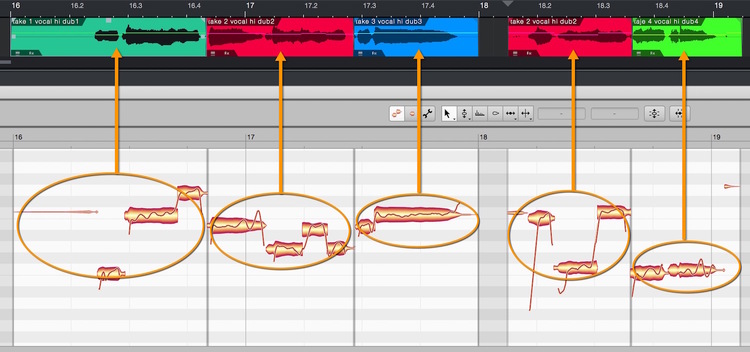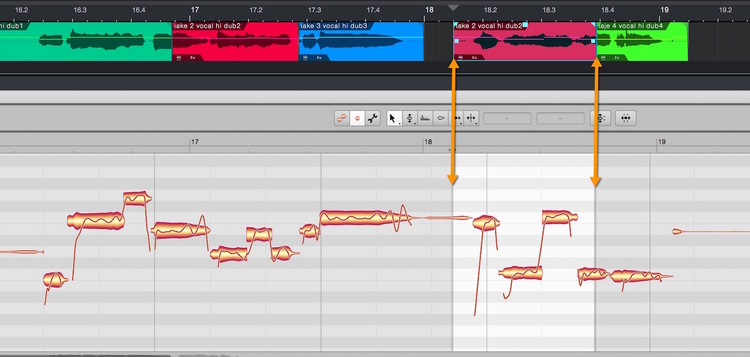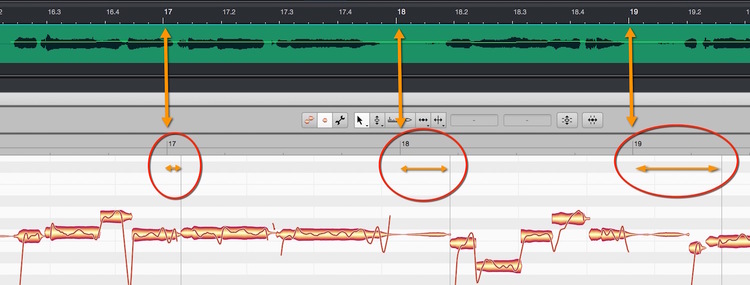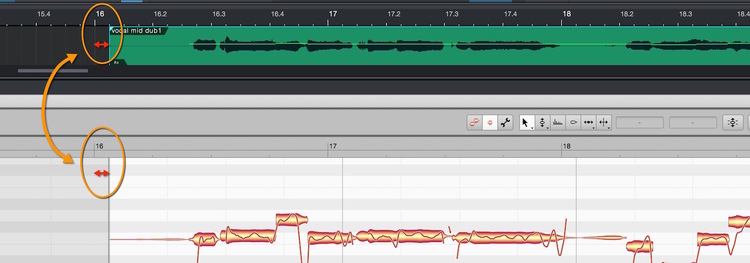Working with ARA
The ARA integration of Melodyne with compatible DAWs is particularly user-friendly. Among its advantages are that no transfers to the Melodyne plug-in are necessary, that Melodyne follows all changes on the DAW track automatically, and that the DAW, too, enjoys the benefit of Melodyne’s tempo detection.
The exact functions and possibilities vary depending upon how a specific DAW implements ARA. This tour offers you a general explanation of ARA integration – so to speak, from the standpoint of, and in relation to, Melodyne.
Track Mode
With ARA integration, after inserting the Melodyne plug-in and opening a DAW track, two alternative modes are available for editing the notes: Track Mode and Clip Mode. You can switch between them using the buttons above the Note Editor. The left-hand button activates Track Mode; the button to the right of it, Clip Mode.

Track Mode lets you see the entire contents of the track opened in Melodyne, however many clips it is composed of in the DAW.

The clip borders are indicated in Melodyne by vertical gray lines. The moving of borders is performed in the DAW, not in Melodyne, but the lines in the Melodyne user interface move accordingly. This allows you to see at once whether a clip change occurs at an unfortunate moment, such as in the middle of a note.
Clip Mode
The alternative to Track Mode is called Clip Mode. You select this by clicking the right-hand mode button (the one with a single blob) above the Note Editor.
In Clip Mode, you see only a single clip from the DAW track at a time. Track Mode and Clip Mode differ in the way notes are displayed at clip borders: whilst in Track Mode, only notes lying within the clip borders determined by the DAW can be seen, in Clip Mode notes on either side of the borders remain visible; you therefore see in Melodyne – in the area with a gray background – what you might hear if you were to resize the clip in the DAW.
If in the Options menu the entry “Follow the Selection in the DAW” is checked, Melodyne’s display follows the clip selection in the DAW.

The ability to reach beyond the borders of the clip has advantages when performing tasks such as comping. (Comping is the technique of selecting from multiple takes the best rendering of each passage and concatenating the chosen clips to obtain what, given the available material, you consider the optimal performance). Notes overlapping the borders of the clips in question pose particular problems when comping. In Clip Mode, such problems can be resolved on the note level simply by moving or shortening the offending notes until they fit neatly within the clip. In Clip Mode, it is also possible to copy notes lying outside the clip borders and paste them into the clip, which can also be very useful when comping.
Switching from Track Mode to Clip Mode and from clip to clip
Whereas in Track Mode it is always obvious what you are looking at – the contents of the entire DAW track currently selected – Clip Mode displays only one of a track’s clips, so before you can switch to Clip Mode, you must indicate clearly which clip you wish to edit. For as long as this remains unclear, the Clip Mode button will be grayed out. In this case, while still in Track Mode, you must make it clear which clip you wish to examine. You can do this in either of two ways:
- By selecting a note, in which case it is obvious which clip interests you: the one containing the note selected
- By making a selection, which, provided all the notes selected belong to the same clip, is equally unambiguous; if they do not, you must narrow your selection – if need be, to a single note.
If no note is selected, Melodyne looks to see which clip or clips are selected in the DAW. If only one clip is currently selected in the DAW, Melodyne opens its contents in Clip Mode. If several clips are selected, you can resolve the ambiguity by simply selecting a note belonging to the track you wish to examine.
Tip: If you are already in Clip Mode and wish to change clips, it is not necessary to switch back to Track Mode in order to do so. Simply click on the desired clip in the DAW, and Melodyne will display its contents immediately. For this to happen, however, the function “Follow the Selection in the DAW” must be activated in the Options menu and Melodyne must be present on the track containing the newly selected clip.
Entering Note Assignment Mode: You can only enter Note Assignment Mode from Track Mode if it is clear from the current note selection which clip you wish to examine. If necessary, therefore, click on one of the notes of the clip you wish to examine in Note Assignment Mode. You can enter Note Assignment Mode from Clip Mode directly, as only one clip can be selected in Clip Mode at a time and it is therefore obvious which clip you intend to examine.

Local playback in Melodyne
If you commence playback from the DAW, using the bar ruler, for example, or the transport buttons, the full arrangement plays back. The DAW mixer then determines the balance between tracks. The same is true if you commence playback by double-clicking on the Melodyne ruler. It is also possible, however, for Melodyne alone to control the playback. We call this “local playback”. With ARA integration, this local playback is started by double-clicking in the background of the Note Editor.

What exactly you hear during local playback depends upon the current edit mode.
Local playback in Track Mode: In this case, you hear all the clips belonging to the track being edited, their extent and order being determined by the DAW.
Local playback in Clip Mode: In this mode, you hear only the clip currently open in Melodyne’s Note Editor. A significant difference arises at the clip borders, however, between this mode of playback and playback in the DAW. During DAW playback, you hear only what lies within the borders of the selected clip. If any notes are incomplete, due to a poorly positioned clip border slicing off the start or end of the note, this is immediately obvious during DAW playback. During local playback, on the other hand, you can hear material lying beyond the borders of the clip (i.e. in areas with a gray background).
This allows you to check out what the result would be if you were to move the clip borders in the DAW. It can also be useful if, for instance, you wish to use the rest of the track – i.e. the material lying outside the clip as currently defined – as a “note supply” from which to “pinch” notes, by copying them and pasting them into the clip you are working on.
Local and DAW playback differ also in respect of playback tempo. This is discussed in the following section.
Tempo and tempo adjustment with ARA integration
One of the strengths of ARA integration lies in the adjustment of the tempo of audio files to the existing song tempo. This functions from a technical standpoint like this: Melodyne “detects” in the case of each audio file (and consequently of each clip in the DAW arrangement) the tempo of the original recording. This works even with takes that were recorded without a click and that therefore contain tempo fluctuations – and works even if they were recorded in a quite different context from the current DAW song e.g. with stems taken from a different song or loops from a loop library. The information “discovered” in this way by Melodyne is then shared with the DAW, which in turn might come back to Melodyne with the request that it “reshape” the playback tempo of the file in question to make it match the song tempo exactly.
This communication, governed by ARA, between Melodyne and the DAW does not preclude human intervention, as there are times when it is only sensible that you, the user, should have some say in it – for example, in the question of whether or not the DAW should “believe” what Melodyne is telling it about the tempo. It may be that you know for a fact that the stems were recorded at a specific constant tempo, and therefore have no desire for Melodyne to engage in the search for a non-existent variable tempo. The procedures by which you can intervene in the process are described step by step in the following section.
- The DAW track must first be brought to a state that allows the tempo of clips to be adjusted to that of the song. This is the responsibility of the DAW itself and is illustrated here by Studio One:

If the file tempo and the current song tempo are identical, a single value with no brackets is displayed in Melodyne’s Tempo field. If two values appear here, you know that Melodyne has detected a file tempo that is different to that of the song. The first value is the tempo of the song (in this example 83 BPM). The value in brackets indicates the tempo Melodyne has detected in the audio file (here 117 BPM).

In Track Mode, too, the song tempo is displayed without brackets, whilst the tempo of the clip over which the playback line is currently passing is shown in brackets. In Note Assignment Mode, where you are examining the “raw” source material, only the file tempo (in our example, the “117”) is displayed.
- Now it is up to you to decide how the conflicting tempos are to be reconciled. To do this, open the Tempo dialog.

“Confirm as File Tempo”: This tells the DAW to take Melodyne’s word for the tempo. This triggers Melodyne’s time-stretching and the tempo of the audio file is adjusted to match that of the song (slowing, in our example, from 117 to 83 BPM). Typical application: You are using an audio file (the tempo of which you do not know) and simply wish it to match that of the song.
“Assign File Tempo”: If you think Melodyne has slipped up in its detection of the file tempo, with this command you can open the Tempo Editor in Assign Tempo Mode and correct the tempo manually. Typical application: Your file consists of a vocal take containing many pauses during which Melodyne can find nothing upon which to base its file detection and as a result, if only in places, gets the tempo wrong. Through tempo assignment you can lend Melodyne a hand, so to speak, to ensure that any subsequent time-stretching proceeds upon the basis of accurate values and delivers musically appropriate results.
“Apply Project Tempo”: In this case, regardless of the tempo detected by Melodyne, you do not wish the file to be subjected to time-stretching. In other words, you have determined that the file and song tempos are identical (which means that no time-stretching is necessary). Choose this option if the audio file was recorded or bounced in the current DAW song. Another application: You had already, using functions supplied by the DAW, adjusted the tempo of the file to the song tempo, before deciding to open a passage within it in Melodyne. Now you wish to change the melody or key in Melodyne but without jeopardizing the tempo adjustment already performed.
“Apply Constant Tempo”: With this command, you can, if necessary, set the file tempo manually. To do this, select the command from the menu and type into the Tempo field the desired tempo. You might wish to do this when you already know the tempo of the recording that you are importing into your song. Suppose, for example, the song tempo is 83 BPM and you are importing from a sampling CD a drum loop the stated tempo of which, in the booklet, is 90 BPM. As a rule, Melodyne will detect the 90 BPM immediately and display “83 (90)” in the Tempo field. To trigger the time-stretching in this case, it would be enough to select “Confirm as File Tempo”. In the event of Melodyne here displaying a value other than 90 BPM for the file tempo, as, for instance, when it interprets the loop in double time and consequently displays “83 (180)”, you can use the “Apply Constant Tempo” command to correct the misapprehension by typing “90” in place of “180”.
Tempo and the Time Grid
The discovery (or explicit definition in the Tempo dialog) of the “correct” file tempo serves other purposes as well as that of musically sensitive tempo adjustment. It makes the work of editing the notes easier, because the file tempo also determines the calibration of the Time Ruler as well as the positioning of the grid lines in the background to the Note Editor.
Imagine, in this case, that you want to move a note a semiquaver (sixteenth note) to the right or left. What you intend, in all probability, is that the exact length of this sixteenth note should be a function of the current song tempo (say 100 BPM). If the Time Grid, however, were still based on the tempo of the original recording (120 BPM, say), then when you attempted to move a note by a semiquaver, it would end up in the wrong place – (the rule here being: the quicker the tempo, the more closely spaced the gridlines). For this reason, the DAW and Melodyne, communicating via ARA, strive to ensure that their rulers and Time Grids provide at all times an “accurate” representation of the current tempo and that any quantization that is undertaken is therefore similarly “accurate”. In the following, an overview taking into account the various edit modes as well as the difference between local and DAW playback.
Tempo display in Track Mode:
- Melodyne’s Tempo field displays a single value: the song tempo in your DAW.
- Melodyne’s ruler and the Time Grid in the Note Editor background are synchronized and they are each calibrated according to the same principle: the faster the song tempo, the smaller the distance between lines.

Tempo display in Clip Mode:
- Melodyne’s Tempo field displays two values (as described above): the song tempo, followed by the file tempo in brackets. A single value is displayed only when the tempo of the file and that of the song are identical.
- Melodyne’s Time Ruler and the Time Grid in the Note Editor background are now no longer necessarily in sync, as the ruler reflects the song tempo, whereas the grid represents the tempo of the file. If the two tempos are not identical, the dashes on the ruler will no longer coincide with the lines of the grid.

This is as it should be and reveals the effect of dynamic time-stretching during DAW playback: the Time Grid, and with it the notes of the original recording, are squeezed or stretched to accord with the song tempo and also, therefore, with the ruler. The results, of course, will only be musically viable if the Time Grid is calibrated on the basis of “accurate” tempo-detection or -input. For this reason, Clip Mode allows you to examine the Time Grid to ensure that it corresponds with the notes. Should this not be the case, you can make the necessary adjustments using the Tempo dialog options described above.
- During DAW playback, the clip follows the tempo of the song i.e. the value before the brackets. This is achieved by stretching or squeezing the original file to match this tempo.
- During local playback, the clip is heard at its original (file) tempo – i.e. at the tempo shown in brackets – and no time-stretching or -squeezing occurs.
Tempo display in Note Assignment Mode:
- Melodyne’s Tempo field displays a single value: that of the original file.
- The ruler and Time Grid are synchronized.
- DAW playback follows the song tempo. Local playback follows the file tempo. There is one difference here: Double-clicking on the Melodyne ruler in this edit mode also starts local playback and not (as in Track and Clip modes) playback from the DAW.
Quantizing notes
As described above in the section entitled “Tempo and the Time Grid”, it is possible – in Clip Mode only – for discrepancies between the ruler and Time Grid to occur. These serve initially as an orientation aid, reminding you perhaps that you have moved a clip in the DAW a sixteenth note backwards, the evidence being that the Time Grid is now a sixteenth note ahead of the ruler.

Such an offset, however, has an effect upon the quantization, because Melodyne uses its own Time Grid for the quantization and not the DAW ruler. In practice, of course, the two are nearly always identical and the quantization therefore mostly behaves in the manner with which users of MIDI editors, for example, will be familiar. But when, as described above, a clip has been moved in the DAW arrangement (perhaps only by a few milliseconds, for creative purposes), in Clip Mode the quantization destinations (i.e. the positions towards which notes will gravitate when quantization occurs) are visually obvious.
Quantization works the same way in Track Mode as in Clip Mode, being based invariably upon the Time Grid of the original file. In Track Mode, however, you see the Time Grid of the DAW, which, in the exceptional cases described above (such as when you have shifted a clip slightly to the left or right in the DAW) can be misleading, as the quantization destinations may be offset slightly from the gridlines. This, however, is merely an optical discrepancy. Switch to Clip Mode if it annoys you, and the quantization destinations and gridlines will again coincide.
Copying and pasting notes
Within a clip, you can copy and paste notes without any restrictions. Whether you can copy a note from one clip and paste it into another depends upon whether or not the two clips are accessing the same audio file.
Example: You have sliced up a drum recording in the DAW into individual clips, sorted them in the DAW arrangement, and are looking at them now in Melodyne’s Track Mode. In this case, you can copy and paste notes freely (because they were originally part of a single long recording) without paying attention to the clip borders.
If, on the other hand, you have made a collage in the DAW arrangement of snippets taken from different recordings – from successive vocal takes, for instance – and are looking at these in Track Mode, you cannot copy and paste notes with the same freedom. In the following illustration, the clips have been color coded to indicate from which of five different takes they are derived:

Here you cannot copy the note selected at the beginning of Bar 17 (or, indeed, any other note derived from a red clip) and paste it into Bar 16, because the destination contains a clip of a different color – in this case, green – which is therefore derived from a different recording. You can, however, paste it into Bar 18, because the content there is derived from the same red take.
The Compare switch
When working in Melodyne, you will constantly be wanting to compare the current state of the edited recording with the original audio files. In addition to the bypass function of your DAW, which deactivates Melodyne altogether, you will find next to the level display in Melodyne a Compare switch that serves a similar purpose.

Unlike the DAW’s bypass function, however, Melodyne’s Compare switch reverses not only the acoustic but also the visual consequences of all editing. It is also the case that;
- the Compare switch affects all clips governed by Melodyne, regardless of track and whether or not they are currently displayed in the Note Editor. The entire song is therefore returned to the state it was in before you began editing notes with Melodyne.
- all changes made to the notes are undone, whether made using the macros or tools.
- any adjustment of the tempo of clips to match that of the DAW is also reversed.
Tip: Working with long files
With ARA, Melodyne always analyzes in its entirety the audio file that is being referenced by a clip, even if you have narrowed the clip’s boundaries before using Melodyne. This has several advantages. It allows you, for instance, to widen the clip boundaries again later without any further analysis by Melodyne being required.
It does mean, however, that there can be a noticeable hold-up when Melodyne is first used on a clip; this would be the case, for example, if the audio file being referenced by the clip was a live recording lasting several hours (which Melodyne would analyze with the Polyphonic algorithm).
We recommend, therefore, that if you just want to edit part of such a recording, you create a new clip containing only the passage in question and then consolidate it before you begin editing with Melodyne. This will create a second, shorter audio file that Melodyne can analyze that much faster.